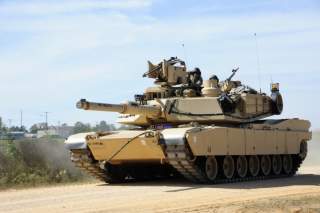The U.S. Army Is the World's Most Lethal, For Now
A recent study seems to show that there isn't a huge difference between the capabilities of U.S. Army equipment, and those of its allies and potential enemies.
How good are U.S. Army weapons compared to their overseas counterparts? Quite good in many areas, but foreign weapons have some capabilities that American weapons don't, according to a new study.
The study, prepared by think-tank RAND Corp. on behalf of the U.S. Army, examined major ground combat systems. Note that it is mostly based on open-source data rather than classified information. Nonetheless, here are some areas where American weapons shined – or didn't:
Tanks and Infantry Fighting Vehicles:
"The U.S. Army’s armored fighting vehicles (AFVs) compare well with their foreign counterparts, particularly the M1A2's Abrams main battle tank, which is widely regarded as the world’s best tank in terms of protection and anti-armor firepower," RAND concludes. Russians, Israelis, and others may disagree with that assessment, but after comparing the Abrams with Russia's T-90, Germany's Leopard and Israel's Merkava, the study praised the Abrams' depleted-uranium armor and antitank ammunition. What the Abrams does lack is a high-explosive fragmentation round, which is found in foreign tanks (though the U.S. Marine Corps uses German-made HE shells).
Foreign tanks also have various capabilities that American vehicles don't, such as active protection systems on Israeli and Russian models, and appliqué top armor on the Leopard.
The U.S. Army's Bradley infantry fighting vehicle also rates favorably against the competition, though the Bradley fitted with the Bradley Urban Survival Kit III (BUSK III) armor kit will have much lower power-to-weight then vehicles like the German Puma, Russian BMP-3, and the Israeli Namer. The Bradley is well-armed with a 25-millimeter cannon and TOW missiles, but the Puma has antitank missile jammers, while the Namer has heavy armor (because it's an actual tank converted to a personnel carrier). As for the BMP-3, "protection is secondary to mobility and cost-effectiveness, which provides insight into Russia’s strategic decisions regarding what qualities are more important for an IFV—protecting the crew is less important compared with vehicle mobility and firepower."
RAND suggests a few options for the Bradley and Stryker, including a bigger gun like the 30-millimeter cannon on the British Warrior, as well as better sensors. "There is no denying that when compared with its foreign counterparts, the main version of Stryker (the infantry carrier) is very lightly armed," the study noted. With the U.S. Army now examining air-droppable armor, the study also noted that Russia has air-droppable BMD vehicles, while China is developing such vehicles.
Artillery:
The U.S. Paladin self-propelled howitzer comes off second-best to the German PzH 2000, because the German howitzer is much more automated. "A quick comparison of the ability of a platoon of four Paladins and four PzH 2000s to deliver fires over a three-minute period shows the limitation of the U.S. system compared with the leader among the world’s self-propelled howitzers," the study says. "While a Paladin platoon could deliver 48 shells in an intense three-minute fire mission, the German platoon could deliver 120 shells—and could do so at distances up to 50 percent greater than Paladin’s maximum range."
In terms of rocket artillery, the American GMLRS is capable, but may soon outranged by Russian and Chinese weapons. "The entrance of the Chinese and their greater emphasis on much heavier, longer-range rockets that begin to bridge the gap between rocket artillery and short-range ballistic missiles could have a significant effect over time in extending the trend toward longer-range strike systems."
Helicopters:
Again, U.S. helicopters are rated as quite capable, with significant advantages in their capacity for manned-unmanned teaming with drones, as well as their third-generation forward-looking infrared (FLIR) sensors. The Eurocopter Tiger carries fewer Hellfire missiles and has less advanced FLIR sensors, the Russian Mi-28 is currently flying without radar and defensive countermeasures, and the Chinese Z-10 still has teething problems. However, non-U.S. helicopters do have the advantage of being cheaper.
What's most interesting about the RAND study is that there doesn't seem to be a huge difference between the capabilities of U.S. Army equipment, and those of its allies and potential enemies. America excels in many areas, other nations excel in a few, but no one really seems to have a huge advantage.
Michael Peck, a frequent contributor to TNI, is a defense and historical writer based in Oregon. His work has appeared in Foreign Policy, WarIsBoring and many other fine publications. He can be found on Twitter and Facebook.
Image: Flickr/The 621st Contingency Response Wing/CC by 2.0

